Winter is coming. And unfortunately, it’s not coming to Westeros. Winter is coming for SaaS. You might have noticed that the economy is not doing very well these days. Inflation is up, interest rates are spiking, and the fear of a downturn is high.

Winter is here for SaaS
This has already affected the tech industry significantly. Layoffs are ripping through businesses, with tech companies cutting headcount left and right. The once high-flying eCommerce darling Shopify recently announced a layoff that affected 1000 employees. Even established giants like Oracle are beginning to slash their workforce in order to save costs.
Along with troubles in the labor pool, there are also signs that SaaS products are coming into a decline, as companies reevaluate their tech stacks and cut down on products they perceive as superfluous. With existing customers canceling subscriptions, a SaaS recession is now a possibility.
The key to surviving this tough time lies in driving users to the product value quickly, delighting them with extraordinary user experience throughout their journey, and increasing product adoption rates. Let’s take a look at why production adoption is your best shield against the SaaS Winter.
Recessions often bring tightening of budgets and that can lead to your customers leaving.
The key to surviving tough times lies in driving users to the product value quickly.
This can be achieved by product adoption.
Product adoption can bring many benefits, which all lead to increasing your revenue.
Setting up a solid product adoption strategy could be the breakthrough maneuver you need to come out stronger from this SaaS Winter.
To find out more about how product adoption can help you, read below.
What happens to SaaS businesses during a recession?
The SaaS industry is quite young, which means it hasn’t experienced many recessions so far. With the exception of the COVID-19 economic downturn - which actually helped many SaaS companies to bloom, there were two notable recessions in the past couple of decades: the dot-com recession and the Great Recession. How have these affected SaaS?
The dot-com recession was actually a signal fire to the coming of SaaS. Salesforce came out with the first SaaS solution built from scratch with their CRM platform in 1999, and the subsequent meltdown of digital companies actually paved the way for subscription-based business models in place of on-premise software.
The Great Recession was the one and only real recession that the SaaS industry experienced. However, many prominent SaaS companies were not there to experience it.
The SaaS boom really kicked off in the 2010s, as the graph below shows. According to Gartner, the global SaaS market size was $9.2 billion in 2010. As of 2022, Gartner reported that global SaaS spending was projected to be well over $170 billion.
Even prominent public SaaS companies like Zapier (founded in 2011), and Monday.com (founded in 2012) have never gone through a proper recession. So it is safe to say that this is the first true economic shock that many SaaS companies will face.
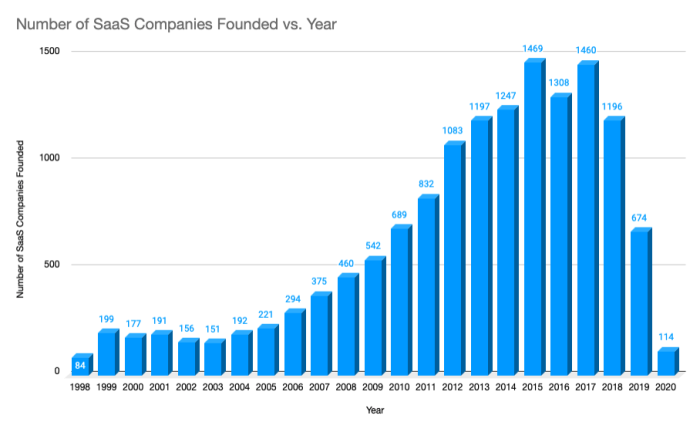
This begs the question: What happens to SaaS businesses during a recession?
The obvious answer is that SaaS businesses tend to grow less during downturns. Below is a chart from the SaaS Capital’s research that aggregates data from 16 SaaS businesses between 2006 and 2011.
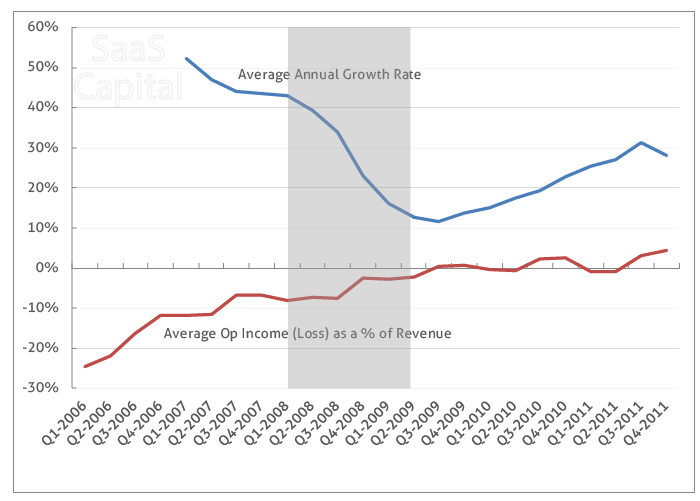
As you can see above, the average annual growth rate for the SaaS companies in the study fell sharply during the Great Recession between 2008 and 2009.
The one silver lining to the SaaS business model is that it is resilient. SaaS businesses have a subscription model, and this makes SaaS companies more stable, as shown by how in the above chart, operating income continued to hold up during the recession years.
Even so, difficult times lie ahead for SaaS businesses. Recessions often bring tightening of budgets and that can lead to your customers leaving. This is why it’s more important than ever to prove to customers that your product is the one they should hold onto, which is exactly where product adoption comes in.
Why product adoption matters for the SaaS Winter
Simply put, product adoption is the process of getting users to start actively using your product in order to achieve their goals. For this to happen, users need to identify the value that your product promises to offer them.
Once this is achieved, it is more likely that a customer will stay with your product, especially through difficult times. If your solution is important for keeping the lights on, why would they churn? Let’s go over in more detail how having a great product adoption process can make a difference in getting through the SaaS Winter.
You can increase revenue (without increasing spend)
The best way to weather an economic storm is to go on the attack. For SaaS products, that means increasing their revenue.
By optimizing your product experience to achieve a higher level of product adoption, you can convert more users, increase retention, motivate upsell, reduce churn, and raise customer lifetime value, all of which is a boost to your bottom line.
This also positively reflects on your value, especially during recessions. When you raise your revenue, that also boosts your company’s value since valuations are often calculated via revenue multiples.
The more revenue you generate, the more likely you are to have money to survive through the tough times. And the more valuable you are because of your increasing revenues, the easier it will be to raise money when you need it.
What’s even better is that with increased product adoption rates, you can push your revenue up without increasing spend. Your product becomes the main driver of acquisition and retention. Essentially, you can set a product-led growth strategy in motion and scale your business.
You can keep your team lean and nimble
The first thing you should pay attention to during a downturn is how you spend your money and time. If you’re being wasteful with your resources, you are not helping yourself to come out of the recession in a better shape, let alone survive.
But when you focus on product adoption as a core element in your growth strategy, you are able to keep your team operating in a very lean and versatile manner.
One big aspect is that it allows your team to be much more efficient. Think of it this way – whenever they need to improve user experience, product teams rely heavily on engineering to implement such adjustments. This creates longer timelines, as well as any inefficiencies that can typically arise when multiple stakeholders across different departments are involved. Not to mention that dev teams are often already swamped even without those asks from product teams.
However, with production adoption software that can layer over your product, developers do not have to be involved. In fact, your Product, Marketing, Research, and Customer Success teams can plan what they want to do and execute right away with a no-code solution that anyone can use. Additionally, this gives your team the ability to move fast and experiment rapidly, allowing you to test hypotheses and iterate with minimal blockages.
Your product becomes essential to your customers
According to Harvard Business Review, during economic downturns, products that are considered ‘essentials’, in other words, necessary for survival, tend to have the least risk for decreasing sales. It’s no different for B2B companies.
When a recession looms, the first thing that companies tend to do is to slam the brakes on spending. That could mean that your product is now also on the chopping block. Whether it’s prospective leads dropping out or renewals not occurring, losing your customers is bad even during normal times, and it’s downright crippling during hard times.
The thing is, value is not always noticeable. Let’s say you provide a feature that you know a user will find invaluable. But if the user is unable to figure out how to properly use the feature, or is even unaware of the feature’s existence in the suite of functionalities you provide, there is more likelihood for churn.
When you focus on how to influence product adoption, you guide your customers to value much faster. The more value your product provides to your customers, the more it becomes irreplaceable, and that makes it much less likely that your product will be cut out.
You can quickly find what works (and what doesn’t)
Product adoption is a two-way street. You create different in-product experiences for users, and they give you feedback through their behavior. Then, based on that feedback, you revise your product to create an even better experience or fix what’s not working about an experience.
This includes feedback that you can gather from product surveys, but also behavioral feedback that shows where users are dropping off, or getting frustrated.
For this purpose, you can use in-app feedback tools such as microsurveys to collect contextual user feedback while they interact with your product, or you can gain more granular insights by integrating your product adoption tool with product analytics tools such as Amplitude, Mixpanel, and Heap.
You can’t fix what you don’t know, but with a product adoption focus, you’ll have a 360-view of what works for your users and what doesn’t. For more about product feedback, check out our article below.

3 User Feedback Types All SaaS Companies Should be Collecting
How to go beyond NPS to obtain user input that creates a better product.
The Product Adoption tech stack
Now that we know product adoption is key to getting through the SaaS Winter, what are the tools that can get you there? We’ll go over three main categories of products you need to have under your belt and give an example of each.
User segmentation
User segmentation is another core part of product adoption. Personalization and the ability to pinpoint behavioral patterns is a vital parts of leading users to value effectively. For that, you need to be able to divide users based on traits such as:
In-product behaviors
Lifecycle stage
Sign-up sources
Role within their company
Recommended tool: Segment
Segment is a customer data tool that collects user events from your app. This gives you a complete picture of your users, from who they are and where they came from, to how they are interacting with your product. You can then use this data to create customer profiles and adjust your user experiences depending on each type.
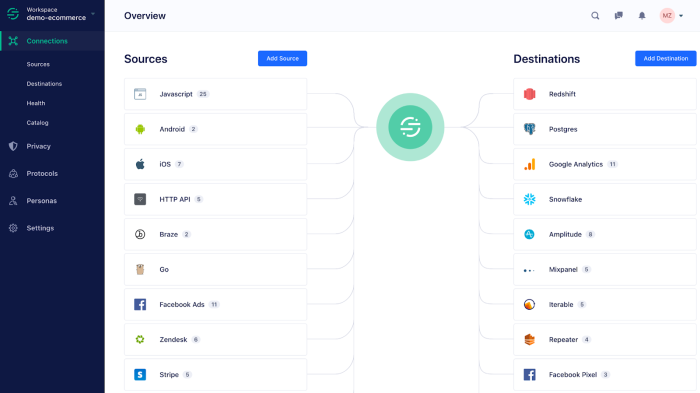
In-product engagement
Most importantly, you need to have an in-product engagement tool that will create user experiences right inside your tools. This includes product tours that guide users through the software, as well as tooltips that give nudges whenever users are blocked.
Recommended tool: Chameleon
Chameleon is a no-code solution that boasts the deepest product adoption software currently available in the market. It offers four key products:
Tours: for guiding users through the product step-by-step
Launchers: for giving easy access to self-serve resources
Tooltips: for unblocking users and giving best practice tips
Microsurveys: for gathering contextual in-product feedback
With a wide range of UI patterns that allow you to personalize customer experiences, it gives far more flexibility and versatility when it comes to creating user flows that will lead to successful product adoption.
Chameleon also offers highly customizable styling, which allows you to create experiences that look native instead of looking like external products that were added on. Here’s an example of a Tour you can build with Chameleon.
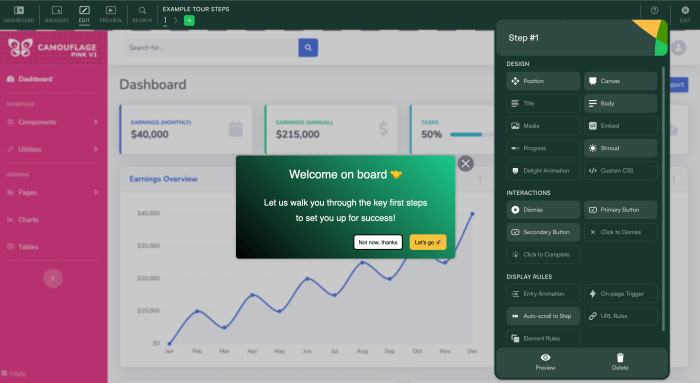
Product analytics
As we said before, feedback is so important when it comes to knowing how to improve your product. Without key product adoption metrics available, you won't know where to focus your efforts, especially when your resources are limited by a downturn.
This is why being able to measure product adoption metrics is a must. For that, you need a great product analytics tool.
Recommended tool: Heap
Heap can help you track user data and identify behaviors that predict long-term value, as well as pinpoint which actions are signs of adoption. Not only that, Heap can show you everything about the path that a user takes towards activation. It can tell you what user behaviors most indicate activation, as well as what channels lead to a higher feature adoption rate.
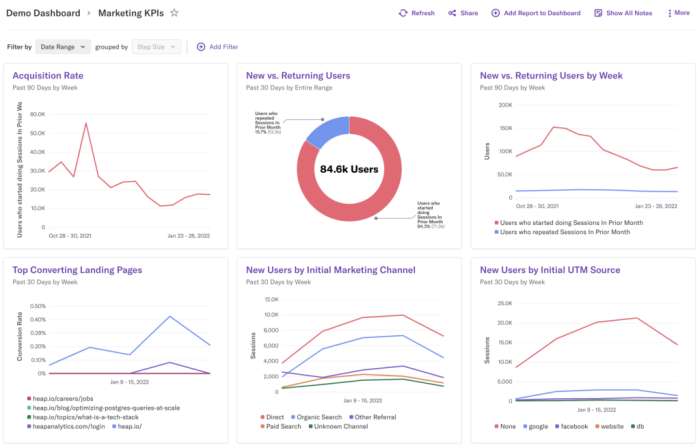
How product adoption can help you navigate through crisis
Now that we have established product adoption as the method of choice for navigating hard times, let’s take a look at a few use cases and real-life examples.
Identifying customers at risk of churn
Reducing churn is critical in a crisis. A hard time pushes your customers to reconsider their software choices. So you have to get ahead of the curve and convince your customers otherwise before they ever come close to deciding to cancel.
For that to happen, the most important thing is to help users see your product as a valuable asset, not just an extra expense they need to cut. But how do you know which users to target? Even if you have strong customer support, you simply can't cover all of your clients at all times. You need to be able to pick out which existing customer is
That is where user segmentation comes in. You can categorize users based on certain criteria to identify whether those users are likely to cancel or not.
As an example, let’s take a look at how The Motley Fool, a financial services company, managed to decrease churn by 9% in 45 days. leverages Segment’s Personas platform for audience management. With user segmentation, The Motley Fool is able to identify which users are at risk of churn.
Armed with this information, Motley Fool can then engage those users by integrating Segment’s data with Chameleon and creating targeted user experiences that would nudge specific users into taking key actions, thereby decreasing the risk for churn.
Generating Product Qualified Leads
Product qualified leads (PQLs) are users who have tried the product already and reached their ‘aha’ moment. In other words, a PQL is a lead that has already found value in the product.
Identifying PQLs is very beneficial, mainly because it helps your Sales team to generate conversions a lot more efficiently. PQLs often only require a minor nudge in order to buy or upgrade, because they have already experienced the value of the product. This cuts the amount of heavy lifting a sales rep would have to do.
For example, if you notice that certain free-trial users are repeatedly performing actions with advanced features or hitting their feature limits, that is a good sign that the user is a PQL.
It can also help your team capture upselling or cross-selling opportunities among existing customers. If you see that some of your customers are frequently getting blocked by the limits of their current plan, then that might be a time to nudge that customer into an upgrade.
For you to have this kind of 360-degree view of your customers’ product behaviors, you need robust product analytics. Having a tool like Mixpanel, Amplitude, or Heap would allow you to see what events lead users to become PQLs.
Once you know this, you can use product adoption platforms like Chameleon to nudge users toward that behavior and generate more PQLs. At that point, your product will literally be selling itself.
Optimizing cancellation flows
When the going gets tough, people start looking for ways to cut spending. That could mean a wave of cancellations on your product.
Fortunately, when they decide to cancel, it’s not necessarily the end. With product adoption tools, you can create cancellation flows that not only give you valuable feedback on why users are cutting your product from their stack, but also can potentially change their minds about leaving.
For instance, with a tool like Chameleon, you can create simple customer feedback mechanisms such as the following.
The point here is to not delay or slow down cancellation, but make intelligent UX choices that actually create opportunities for you, whether that is making them rethink their choices about canceling by highlighting some of the features they would be missing out on, or collecting valuable feedback that you could use to prevent more cancellations.
Saving time & money
At the end of the day, weathering out the storm is about being able to convince more users of the value of your product. That means an increased user activation rate, which is a measure of how fast your users are discovering value from your offering. This can drive everything from raising revenue via conversion or upsell, to reducing churn because users see the full value of your product.
But adjusting your user flows is often a resource-heavy task. Developers have to be involved, and that could mean weeks or even months of production. In crisis mode, you don’t have that luxury. You have to be fast, nimble, and effective. With a product adoption tool that handles in-product experiences with no code needed, you can save money and time while also boosting activation rates.
Here’s a real-life example. Vovox, a cloud communication services firm, had a product that was having an activation problem. Their existing 30-second flow led users to miss out on being aware of the product’s core features.
So, they used Chameleon to set up a variation of the onboarding flow that was focused on introducing users to their various features. The results were astounding: a 50% reduction in churn and a 20% increase in user activation.
Voxox estimated that the cost of building another onboarding flow instead of using a product adoption tool would have been around $50k, not to mention the time it would have taken. With Chameleon, they were able to instantly deploy an adjustment at a fraction of the cost.
Conclusion
As budgets tighten up across the industry and prospects seem to dwindle for the near future, it is easy to feel that now is the time to curl up and ride out the storm.
But on the contrary, in times of challenge, there are always opportunities. Just as the Great Recession teed off the next generation of big winners in tech, this could be the once-in-a-generation chance for massive growth. Setting up a solid product adoption strategy could be the breakthrough maneuver.
Remember, diamonds are made under pressure. Keep your eye on the prize, and never stop delighting your customers. This SaaS Winter may be the launchpad you need to cruise into Spring.
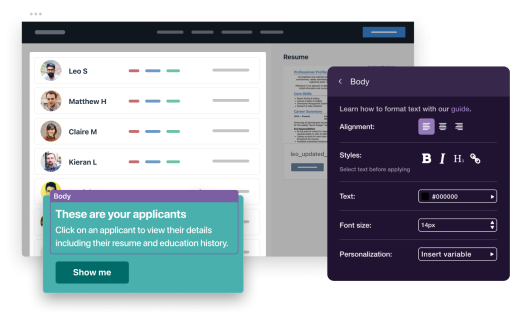
Leverage Product Adoption to Survive the SaaS Winter
Create experience that delights users and boosts your revenue




